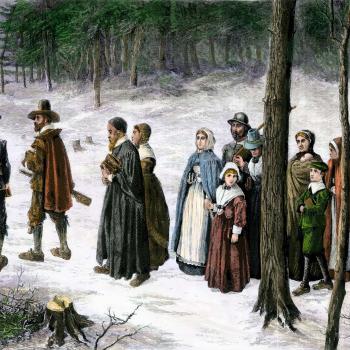Thee was a time when creationists simply argued that Neanderthals and all the other “supposed” missing links in human evolution were simply fakes. They continuously argued that these bones were hoaxes. When it comes to Answers in Genesis, though, the argument regarding human evolution has changed. Or, one might say, evolved.
Today, rather than denying the existence of Neanderthals, Cro-Magnon Man, Homo Erectus, and Homo Floriensis, Answers in Genesis argues that the descendants of the eight humans who survived the global flood (circa 2350 B.C.E.), and then a hundred years later built the Tower of Babel, evolved, through genetic variation, into these different groups, all of which were fully human and had souls. Then, almost as suddenly, all of the groups except for Homo Sapiens became extinct. Here is an excerpt from “How are Cavement Different,” by Georgia Purdom (Answers Magazine, vol. 7, no. 2, pp. 57-59).
Genetics has clearly established that Neanderthals and Denisovans were fully human. Any physical differences should be viewed as nothing more than variations that can occur within the human race descended from Adam and Eve. For a time, these descendants all lived together at the Tower of Babel. Following the post-Babel migration and late into the Ice Age, differing human populations began to appear in the fossil records, such as Neanderthals and Denisovans.
The next questions for creationists are how and why these differences appeared. How is much easier to answer than why! One possibility is that environmental pressures, such as the Ice Age, “selected” for or against traits within the range of human genetic diversity. (In other words, those that had a particular combination of traits survived in that environment, and others did not.) This may have led to the specific set of features found in Neanderthal people. Many animals following the Flood and during the Ice Age experienced an explosion of variations that allowed them to live and function well in new environments. This could also have been true for humans.
Other possibilities include genetic effects seen mainly in small populations. Small populations would have been typical for a period of time following the breakup of the human population at Babel, as people were separated based on language. The groups that left Babel would have begun with only a few reproducing individuals and not interbred initially with other groups.
A phenomenon known as genetic drift can cause certain genetic variations to become “fixed.” If the population is small, everyone with certain variations can die, without passing them down, and the survivors pass down just one variation to future generations. If no people are moving in or out of the population, characteristics like the pronounced brow ridge or the robust body form in Neanderthals can become dominant.
Another possible impact of the Babel breakup is the founder effect. The founders of each group leaving Babel might simply have differed from one another. Certain traits in one group might have been unknown among the founders of any other group. Those traits would then be unique to each group. Rather than being fixed by genetic drift, the Neanderthal’s pronounced brow ridge or robust body form may have been found among the founders of only one group after they left Babel. Those people may have migrated intentionally to places where they were most comfortable (similar to human behavior today).
As time passed, the different groups would have migrated, as people have always done. People who had the traits of modern humans possibly interbred, at times, with teh other groups, such as Neanderthals and Denisovans. Yet there seems to have been a sudden loss, or a dilution, of the characteristics possessed by those other groups. The genetic makeup of modern humans became dominant.
Interbreeding can have disastrous effects on small populations by amplifying defective genes. Maybe this is why Neanderthals and Denisovans eventually became extinct. We don’t know. Why this happened is still a mystery.
What is not a mystery is that so-called cavemen, including Neanderthals and Denisovans, were fully human. They were among the descendants of the people scattered at the Tower of Babel – made in God’s image to bring Him glory.
Realize that this is a very new argument. Until relatively recently, creationists focused on calling Neanderthals and all the rest haoxes. This is telling, because it indicates that the evidence for the existence of Neanderthals and other human relatives or ancestors has become so strong that creationists are having a harder time simply rejecting it altogether and must instead grapple with it. Creationism has evolved a great deal since the days of the Scopes Trial and William Jennings Bryan.
Another point to be mentioned is that creationists like those of Answers in Genesis like to sound like they’re doing real science. A layman might pick up this copy of Answers, read it, and be taken in, because on its surface it sounds scientific. Rather than sounding backwards or ignorant, it sounds on its surface like there really are several different scientific ways to understand the timing and placement of the Neanderthals. Except of course that it’s complete nonsense. The picture painted in this article does not actually align with the evidence we see at all. But it sure sounds neat and tidy!
Finally, I think it’s fascinating how openly creationists have embraced evolution. For a population of eight people to have become different species in only a few generations is extraordinary (and impossible), and if it happened, would represent evolution on a scale never before seen. What is mind boggling is that creationists could argue for evolution of this magnitude and yet continue to deny the theory of evolution.














